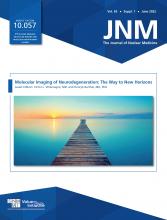Abstract
The improvement of existing techniques and the development of new molecular imaging methods are an exciting and rapidly developing field in clinical care and research of neurodegenerative disorders. In the clinic, molecular imaging has the potential to improve early and differential diagnosis and to stratify and monitor therapy in these disorders. Meanwhile, in research, these techniques improve our understanding of the underlying pathophysiology and pathobiochemistry of these disorders and allow for drug testing. This article is an overview on our perspective on future developments in neurodegeneration tracers and the associated imaging technologies. For example, we predict that the current portfolio of β-amyloid and tau aggregate tracers will be improved and supplemented by tracers allowing imaging of other protein aggregation pathologies, such as α-synuclein and transactive response DNA binding protein 43 kDa. Future developments will likely also be observed in imaging neurotransmitter systems. This refers to both offering imaging to a broader population in cases involving the dopaminergic, cholinergic, and serotonergic systems and making possible the imaging of systems not yet explored, such as the glutamate and opioid systems. Tracers will be complemented by improved tracers of neuroinflammation and synaptic density. Technologywise, the use of hybrid PET/MRI, dedicated brain PET, and total-body PET scanners, as well as advanced image acquisition and processing protocols, will open doors toward broader and more efficient clinical use and novel research applications. Molecular imaging has the potential of becoming a standard and essential clinical and research tool to diagnose and study neurodegenerative disorders and to guide treatments. On that road, we will need to redefine the role of molecular imaging in relation to that of emerging blood-based biomarkers. Taken together, the unique features of molecular imaging—that is, the potential to provide direct noninvasive information on the presence, extent, localization, and quantity of molecular pathologic processes in the living body—together with the predicted novel tracer and imaging technology developments, provide optimism about a bright future for this approach to improved care and research on neurodegenerative disorders.
- © 2022 by the Society of Nuclear Medicine and Molecular Imaging.







